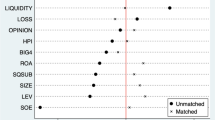Abstract
In this paper, we aim to include rule making, implementation, monitoring and enforcement costs into the cost comparison of policy instruments. We use a simple partial equilibrium model and apply it to the textile industry. The model includes discrete abatement functions and costly monitoring and enforcement. The case study uses individual firm data to simulate the differences in abatement costs and compliance decisions between firms. We compare combinations of regulatory instruments (emission taxes, emission standards and technology standards) and enforcement instruments (criminal fines, civil fines and transaction offers). We show that the inclusion of information, monitoring and enforcement costs indeed alters the relative cost efficiency of the different instruments.
Similar content being viewed by others
References
T. S. Aidt (1998) ArticleTitle‘Political Internalization of Economic Externalities and Environmental Policy’ Journal of Public Economics 69 1–16 Occurrence Handle10.1016/S0047-2727(98)00006-1
Ando, A. W. (1998), Do Interest Groups Compete?. RFF Discussion Paper 98–14
Beccaria, C. (1770), ‘On Crimes and Punishments, and Other Writings’, in R. Bellamy and R. Davies et al. (eds.), trans., New York: Cambridge University Press
G. S. Becker (1968) ArticleTitle‘Crime and Punishment: An Economic Approach’ Journal of Political Economy 76 IssueID2 169–217 Occurrence Handle10.1086/259394
Bentham, J. (1789), ‘An introduction to the principles of morals and legislation’, in The Utilitarians, Rept. Garden City, New York: Anchor Books
Billiet, C. M., S. Rousseau and S. Proost (2002), Law & Economics and the Choice of Environmental Policy Instruments. Final report HL/DD/14. http://www.belspo.be/belspo/fedra/proj.asp?|=nl&COD=HL/DD/14
M. Boyer J. J. Laffont (1999) ArticleTitle‘Toward a Political Theory of the Emergence of Environmental Incentive Regulation’ RAND Journal of Economics 30 IssueID1 137–157
Centexbel (1996), Haalbaarheid afvalwaternormen in de Vlaamse textielnijverheid. Report
Cohen, M. A. (2000), ‘Monitoring and Enforcement of Environmental Policy’, in T. Tietenberg and H. Folmer (eds.), ‘International Year Book of Environmental and Resource Economics’, Edward Elgar Publishers
R. Damania (1999) ArticleTitle‘Political Competition, Rent Seeking and the Choice of Environmental Policy Instruments’ Environmental and Resource Economics 13 415–433 Occurrence Handle10.1023/A:1008299920714
C. Dion P. Lanoie B. Laplante (1998) ArticleTitle‘Monitoring of Pollution Regulation: Do Local Conditions Matter?’ Journal of Regulatory Economics 13 IssueID1 5–18 Occurrence Handle10.1023/A:1007970031068
L. S. Dixon (1995) ‘The Transaction Costs Generated by Superfund’s Liability Approach R. Revesz R. B. Steward (Eds) Analyzing Superfund: Economics, Science and Law Resources for the Future Washington, DC 171–185
L. H. Goulder I. Parry R. C. Williams III D. Burtraw (1999) ArticleTitle‘The Cost-Effectiveness of Alternative Instruments for Environmental Protection in a Second-Best Setting’ Journal of Public Economics 72 329–360 Occurrence Handle10.1016/S0047-2727(98)00109-1
J. D. Harford (1978) ArticleTitle‘Firm Behavior under Imperfectly Enforceable Pollution Standards and Taxes‘ Journal of Environmental Economics and Management 5 26–43 Occurrence Handle10.1016/0095-0696(78)90003-7
W. Harrington (1988) ArticleTitle‘Enforcement Leverage When Penalties are Restricted’ Journal of Public Economics 37 39–53 Occurrence Handle10.1016/0047-2727(88)90003-5
Heyes, A. (2001), The Law and Economics of the Environment. Edward Elgar
Hopkins, T. D. (1996), Regulatory Costs in Profile. Center for the Study of American Business, Policy Study no. 132
Jacobs A., L. Bettens, A. De Grijse and R. Dijkmans (1998), Best beschikbare technieken voor de textielveredeling. VITO. Academia Press
A. G. Keeler (1995) ArticleTitle‘Regulatory Objectives and Enforcement Behaviour’ Environmental and Resource Economics 6 73–85 Occurrence Handle10.1007/BF00691412
Kolstad, C. D. (2000), Environmental Economics. Oxford University Press
A. S. Malik (1992) ArticleTitle‘Enforcement Costs and the Choice of Policy Instruments for Controlling Pollution’ Economic Inquiry 30 714–721
Ministry of the Flemish Community (11 June 2001), Milieuhandhavingsrapport 2000 en het 10-jarig bestaan van de Vlaamse Milieu-inspectie. Press Release
Montesquieu, C. (1748), The Spirit of the Laws. Rept. edition. Berkeley: University of California Press
W. E. Oates P. R. Portney A. M. McGartland (1989) ArticleTitle‘The Net Benefits of Incentive-based Regulation: A Case Study of Environmental Standard Setting’ American Economic Review 79 IssueID5 1233–1242
OVAM (1996), Sectorstudie bedrijfsafvalstoffen: loontextielveredeling. Report
A. M. Polinsky S. Shavell (2000) ArticleTitle‘The Economic Theory of Public Law Enforcement’ Journal of Economic Literature 37 IssueIDMarch 45–76
R.A. Posner (1974) ArticleTitle‘Theories of Economic Regulation’ Bell Journal of Economics and Management Science 4 335–359
PRESTI project (1994–1997), Handleiding voor de modelaanpak van preventieve milieuzorg – Textielsector. Report
K. N. Probst D. Fullerton R. E. Litan P. R. Portney (1995) Footing the Bill for Superfund Cleanups. Who Pays and How? The Brookings Institute and Resources for the Future Washington, DC
Rousseau S. (2005), Selecting environmental policy instruments in the presence of incomplete compliance. Doctoral dissertation. Catholic University of Leuven
Rousseau S. and C. M. Billiet (2003), Using Emission Standards under Incomplete Compliance. ETE Discussion Paper 2003-03
Rousseau S. and S. Proost (2004), The Relative Cost Efficiency of Market-based Environmental Policy Instruments with Imperfect Compliance. ETE Discussion Paper 2004-15
A. Sandmo (2002) ArticleTitle‘Efficient Environmental Policy with Imperfect Compliance’ Environmental and Resource Economics 23 IssueID1 85–103 Occurrence Handle10.1023/A:1020236324130
J. Slemrod N. Sorum (1984) ArticleTitle‘The Compliance Cost of the US Individual Tax System’ National Tax Journal 37 IssueID4 461–474
G. J. Stigler (1970) ArticleTitle‘The Optimum Enforcement of Laws’ Journal of Political Economy 78 526–536 Occurrence Handle10.1086/259646
Author information
Authors and Affiliations
Corresponding author
Rights and permissions
About this article
Cite this article
Rousseau, S., Proost, S. Comparing Environmental Policy Instruments in the Presence of Imperfect Compliance – A Case Study. Environ Resource Econ 32, 337–365 (2005). https://doi.org/10.1007/s10640-005-6646-6
Accepted:
Issue Date:
DOI: https://doi.org/10.1007/s10640-005-6646-6
Keywords
- efficiency
- environmental management
- government policy
- illegal behaviour and the enforcement of law
- transaction costs




